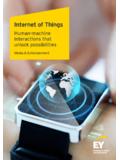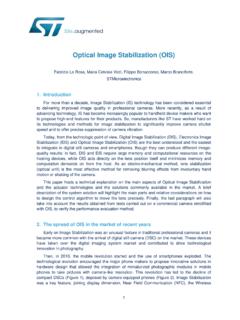Transcription of The mobile apps industry: A case study - AABRI …
1 Journal of Business Cases and Applications The mobile apps industry , page 1 The mobile apps industry : a case study Thomas L. Rakestraw Youngstown State University Rangamohan V. Eunni Youngstown State University Rammohan R. Kasuganti Youngstown State University ABSTRACT From its origins with the advent of Apple s iPhone in 2007, to an industry that could potentially be worth as much as $100 billion by 2015, the mobile apps industry has experienced nearly unprecedented growth. The unique aspects of the industry are discussed in terms of how they have encouraged the widespread popularity of smartphones and other mobile devices and have transformed electronic gaming, internet retailing, and social networking.
2 As major competitors in this arena, Apple and Google have endeavored to distinguish themselves in terms of their relationships with app developers, numbers and uniqueness of apps available, as well as the marketplaces in which the apps are sold. While these battles are waged, others (Blackberry RIM, Facebook, and Amazon) have continued to find their loyal users and niches in the market. Forecasts unanimously paint a very bright future for the industry , but potential stumbling blocks remain in the form of, monetization difficulties, accusations of exploiting children, and security and privacy issues. Keywords: industry Analysis, Porter s Five Forces, High Velocity Industries Copyright statement: Authors retain the copyright to the manuscripts published in AABRI journals.
3 Please see the AABRI Copyright Policy at Journal of Business Cases and Applications The mobile apps industry , page 2 EVOLUTION OF THE industry Since the advent of the iPhone in early 2007, users could experience the functionality of personal computers on pocket-sized devices. These so-called smartphones and their associated mobile software applications or apps are becoming increasingly ubiquitous in our daily life. According to , a website dedicated to cataloging and rating apps , the one millionth app was made available to users in December, 2011. Even with many of these apps being duplicates, or slight variations created for different devices ( , an app created for the iPhone and the iPad would be counted twice), that is an incredible explosion of interest for such a new industry .
4 The growth in mobile apps has shown no signs of slowing, with as many as 15,000 new apps being released each week (Frierman, 2011). The proliferation of apps being developed can only be expected to continue as smartphone usage grows globally. In a 2011 study conducted jointly by Google and Ipsos MediaCT Germany, data were obtained via random telephone interviews from amongst the general populations of the United States, United Kingdom, Germany, France, and Japan. The highest reported smartphone ownership was found in the United Kingdom (45% of those interviewed) and the United States (38% of those interviewed). Even more telling is the 50% increase in ownership that occurred in the United Kingdom between the first phase of the research conducted in January and February of 2011 and the latter phase in September and October of that year (The mobile Movement, 2011).
5 There is clearly a shift in usage from computers to mobile devices. In 2010, smartphones outsold personal computers, which caused tech analysts to shift their attention to the handheld platform. During the fourth quarter of 2010, million smartphones were shipped worldwide, whereas only million units had been shipped in the corresponding quarter of 2009. According to Flurry, a company that collects mobile -software data and provides consulting services to software developers, in 2011, smartphone and tablet shipments exceeded the shipments of desktop and notebook computers combined. Software developers are increasingly realizing that in the near future smartphones could replace many core functions of personal computers, such as e-mailing, instant messaging, web browsing, and even gaming (Smartphone mobile Applications To Overtake Standard Websites in Near Future, 2012).
6 Further, in comparing publically available data pertaining to Internet usage with their own client data concerning mobile app usage, Flurry concluded that users are spending more time on mobile apps than on the Internet, as indicated in Table 1 (Appendix)(Newark-French, 2011). Evidence also suggests that these devices are becoming more and more important in people s lives. In another study conducted by Google in partnership with Ipsos OTX MediaCT, 5,013 adults in the United States who identified themselves as using a smartphone to access the Internet were interviewed in the last quarter of 2010. Eighty-nine percent of those interviewed reported using their smartphones throughout the day and 68% reported having used an app in the previous week.
7 Seventy-nine percent of respondents reported using their smartphones to help with shopping, and 22% reported using apps on their smartphones to make purchases (The mobile Movement, 2011). The continued importance of smartphones and mobile apps was highlighted in President Obama s order that all major federal agencies make at least two public services available on mobile phones by May 2013. The intention of the president s order was to encourage innovation and stimulate employment in the field of mobile communications. Others have expressed hope that this initiative would lead to the government making information available to outside Journal of Business Cases and Applications The mobile apps industry , page 3 developers that would facilitate the creation of applications to take full advantage of available government data.
8 It is also anticipated that the increased demand created by those availing themselves of these governmental services would create pressure on the government to free up bandwidth for use by mobile carriers. In sum, President Obama s efforts will greatly add to the groundswell behind the burgeoning field of mobile apps (Melvin, 2012). BASICS OF THE mobile apps industry Although the mobile apps industry began with Apple s introduction of the iPhone, its phenomenal growth is due to the entry of several competitors into the marketplace, notably Motorola, LG, and Samsung. This competition has given rise to an entirely new product space known as smartphones. Smartphones have far greater functionality than normal mobile phones due to their ability to run mobile apps .
9 These applications confer on smartphones the capabilities to send and receive e-mail, play music, movies, and video games, and even communicate remotely with computers from virtually anywhere in the world (Coustan & Strickland, ). Smartphones contain many of the same components as personal computers. Every smartphone has a processor, random access memory stick(s), USB ports, display adapters, and internal storage devices. Users may even customize and upgrade their devices to suit their individual needs. For example, a user who wishes to use the smartphone for gaming can purchase a device with a multi-core processor and additional storage to hold large games.
10 Most smartphones are also equipped with a touchscreen obviating the need for a physical key board. USB peripherals such as audio headphones and data transfer cables are also available for smartphones (Coustan & Strickland, ). The core software found in a smartphone is called the operating system. The operating system contains all the drivers necessary to carry out instructions between the software and hardware of the device. The operating system can be visualized as a software stack consisting of several layers. First, the kernel manages the drivers that manipulate a smartphone's hardware, such as its built-in camera or USB ports. Middleware contains software libraries which link to mobile applications.
















